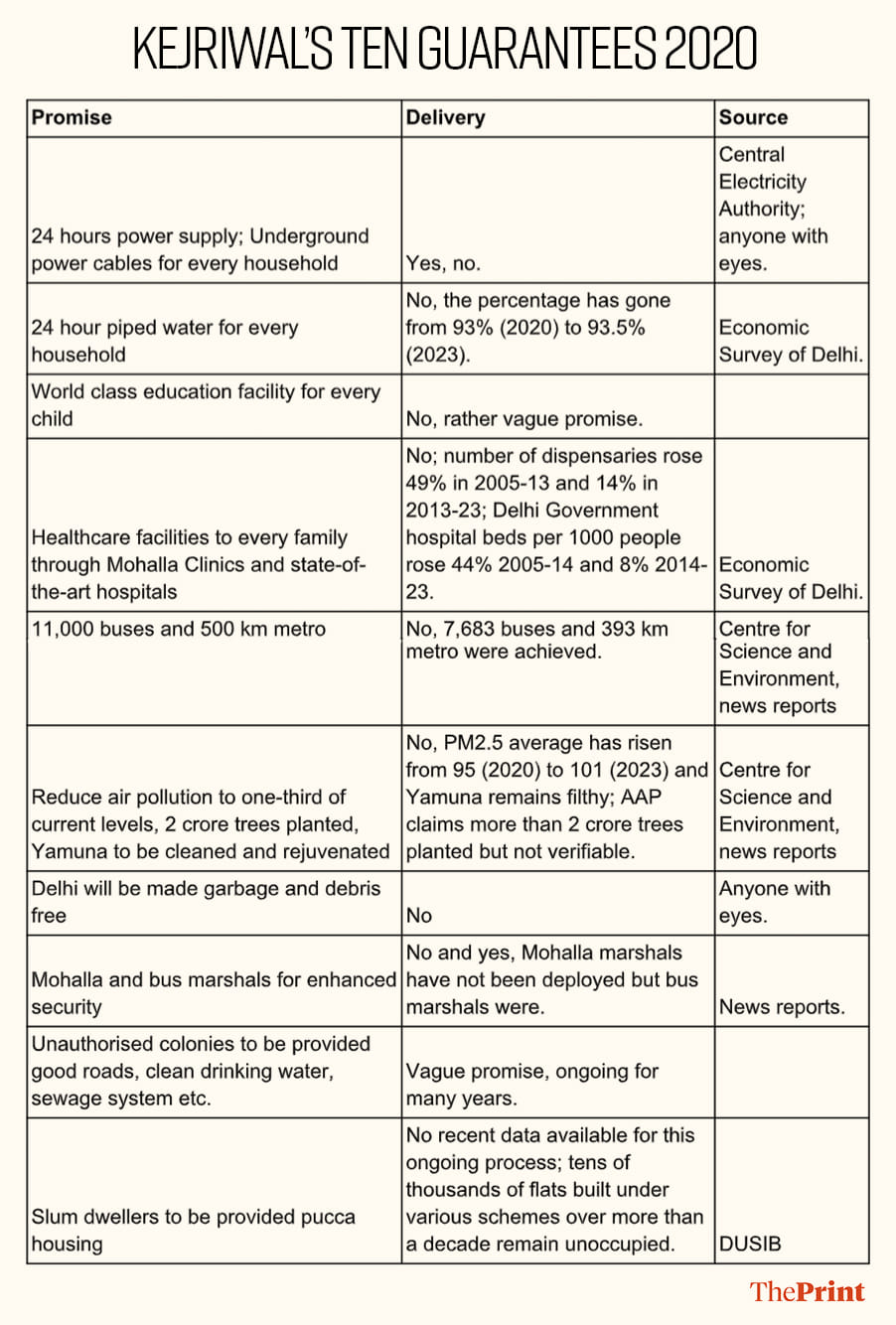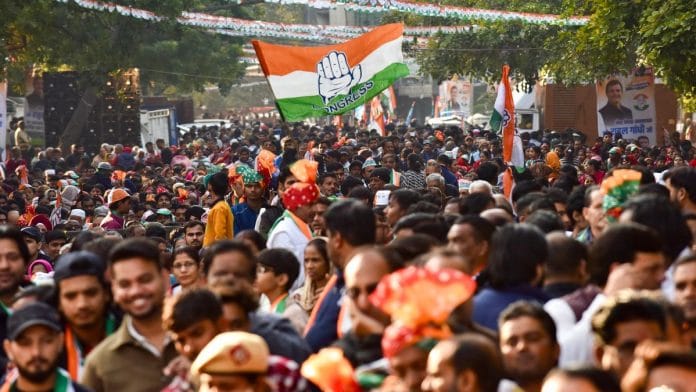The resurgent Congress party campaign shows that it’s back in the game in Delhi. This has contributed to higher uncertainty about the Delhi state election. There is an expectation that the Congress has a good chance in its traditional bastions where it has strong candidates and where reporters are finding renewed interest in the party. But potential Congress voters are confronted with the persistent question of whether voting for the underdog would simply help the Bharatiya Janata Party.
That’s certainly what Arvind Kejriwal wanted them to think when he referred to the Congress on 29 January as a “vote cutter” party, and asked voters not to “waste” their votes on it. This is a bit rich coming from someone who, in 2022, helped the BJP win in Goa, Gujarat and Uttarakhand by doing just that.
There are some excellent reasons to vote Congress in Delhi. First, the Aam Aadmi Party (AAP) has failed to implement most of its 2020 election promises. Second, unlike AAP, the Congress is not content to carve out a niche for itself within the edifice of Hindu Rashtra— without challenging the BJP’s majoritarian and authoritarian vision, including its polarising politics in Delhi. Third, contrary to the “vote cutter” narrative, it is entirely feasible that a resurgent Congress takes away votes from dissatisfied AAP voters that would otherwise have gone to the BJP. Fourth, unlike the Sheila Dikshit government, AAP has underfunded and neglected capital expenditure that is needed, for instance, to build hospitals and expand sewage treatment plants.
AAP at its core represents an anti-political, middle-class sensibility. A populist like Narendra Modi and Donald Trump, Kejriwal positions himself as a heroic individual battling a corrupt system, whose honesty and drive will rescue the struggling citizen from this morass. Elected officials and civil servants are just distractions in this story, and citizens’ only responsibility is to be grateful.
With this attitude comes a disdain for accountability. Is the Yamuna still too polluted for Kejriwal to take his long-promised dubki? No problem, let’s blame ammonia “poisoning” from Haryana even though his own Economic Survey of Delhi 2023-24 states that the 26 km stretch from Wazirabad to Okhla accounts for 76 per cent of the pollution in the river.
Also read: Kejriwal’s SC/ST scholarship scheme is flawed. It lacks intent
Did AAP do what it promised?
In line with this attitude, it is remarkable how little of the AAP’s 2020 Delhi manifesto was implemented.

There were 28 additional promises in AAP’s 2020 manifesto, of which, at best, five have been implemented. No Delhi Jan Lokpal Bill, no Delhi Swaraj Bill, no doorstep delivery of ration, no pilgrimages for 10 lakh senior citizens, no Yamuna riverside development, no 24×7 markets, no “world-class” roads. For a populist, accountability is meaningless.
Many of the achievements AAP takes credit for are also built on deception. High CBSE pass rates in Delhi government schools? That’s because it weeds out weaker students from Class 6 onwards, and diverts weaker Class 9 and 11 students to parallel Patrachar Vidyalayas and NGO-run schools. Student enrollment in Delhi government schools actually fell from 16.1 lakh (2013-14) to 15.05 lakh (2019-20) before Covid bumped it up to 17.6 lakh (2023-24). This weeding-out strategy aimed only at generating positive headlines disproportionately hurts those belonging to disadvantaged communities.
Furthermore, AAP has funded its welfare schemes by sharply reducing spending on asset creation. Capital expenditure almost halved from 41.7 per cent of the state budget before AAP to 22.4 per cent in the AAP regime. For instance, the number of Delhi government hospitals went from 31 (2005) to 39 (2014) under the Congress government. They went up only by one to 40 (2023) under AAP. The Economic Survey of Delhi shows that the number of Delhi government hospital beds (per 1,000 people) rose 44 per cent under the Congress (from 0.43 in 2005 to 0.62 in 2014) and only 8 per cent under AAP (0.67 in 2023).
These are telling numbers about the performance of AAP versus Congress.
Kejriwal is also content to operate within the confines of the Hindu Rashtra project rather than challenge its foundations. He was silent when Muslims felt targeted by the National Register of Citizens (NRC) and even spoke disdainfully of the Shaheen Bagh protests. Unlike Rahul Gandhi and other Congress leaders, he never bothered to visit the riot-affected areas after the Delhi riots of 2020.
Nor does he show any interest in challenging caste hierarchy despite ritual genuflections to Babasaheb Ambedkar. Kejriwal announced a Rs 18,000 monthly salary for Hindu priests and Sikh granthis, but left out Buddhist monks and Dalit priests in temples to Sant Ravi Dass and Maharishi Valmiki. This is perhaps unsurprising for someone who started off as an anti-reservation crusader with Youth for Equality.
Also read: AAP’s Delhi model is all about staying in the news. Can’t win elections without ideology
Grounds for revival
These are the realities feeding Congress’ revival in Delhi. The Congress’ vote share drop in 2015 was driven by the movement of many groups—especially Dalits and minorities—to the AAP. Religious polarisation in the aftermath of the NRC protests in 2020 caused much of what was left to shift to the AAP, in the case of minorities, and to the BJP, in the case of Dalits, OBCs, Gujjars and Punjabi Khatris according to Lokniti-CSDS. With AAP’s failures becoming evident and Kerjiwal’s image damaged by corruption allegations, much of this vote could return.
There is a presumption that a resurgent Congress can only eat into AAP votes since they have overlapping voter bases consisting of the poor, Dalits and minorities. But it is equally possible that Congress provides an alternative to dissatisfied AAP voters who would otherwise end up being forced to vote for the BJP. In the 2018 Chhattisgarh election, many Congress leaders feared that former Chief Minister Ajit Jogi’s Janta Congress Chhattisgarh would eat into their votes. But when votes were counted it turned out that the BJP had been damaged instead.
The Congress’s 2025 Delhi Manifesto has a mix of promises, some that hold out immediate welfare and others that are concrete investments in Delhi’s future, libraries, micro-sewage treatment plants to manage waste at source, incentives to switch to electric rickshaws, hydrogen-fuelled buses, community colleges that issue diplomas suitable for services professionals together with a job-generating investment push in tourism. These promises are meant to be kept. Even its critics have got to admit that the Congress knows how to build a solid foundation, and that is what we are promising for Delhi.
Amitabh Dubey is a Congress member. He tweets @dubeyamitabh. Views are personal.
(Edited by Theres Sudeep)






